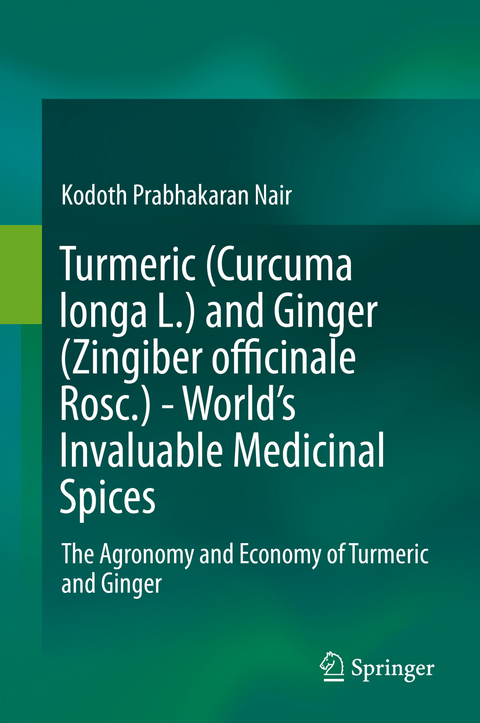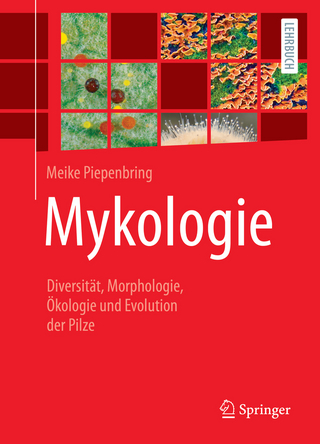
Turmeric (Curcuma longa L.) and Ginger (Zingiber officinale Rosc.) - World's Invaluable Medicinal Spices
Springer International Publishing (Verlag)
978-3-030-29188-4 (ISBN)
This book discusses the various aspects, from production to marketing of turmeric and ginger, the world's two most important and invaluable medicinal spice crops. The book begins with their origin and history, global spread, and goes on to describe the botany, production agronomy, fertilizer practices, pest management, post-harvest technology, pharmacology and nutraceutical uses. The book presents the economy, import-export and world markets involved with reference to turmeric and ginger. It would be a benchmark and an important reference source for scientists, students, both undergraduate and post graduate, studying agriculture and food sciences and policy makers. It would be of great interest to professionals and industry involved in spice trade.
Prabhakaran Nair finished his Doctoral research, specializing in soil fertility and plant nutrition, at Asia’s premier research and post graduate studies institute in New Delhi, India, the Indian Agricultural Research Institute in 1965 and thereafter worked for five years doing postdoctoral research at the State University of Ghent, Belgium. Thereafter, Professor Nair worked as Senior Research Officer and Associate Professor at Asia’s premier agricultural university, G.B.Pant University of Agriculture & Technology, Pantnagar, India. Professor Nair received the Senior Fellowship of the world renowned Alexander von Humboldt Research Foundation, The Federal Republic of Germany, and worked at the Institute of Plant Nutrition, Justus von Liebig University, Giessen, and later, at the Institute of Plant Nutrition, University of Hohenheim, Stuttgart. Developed “The Nutrient Buffer Power Concept”, working with Professor Konrad Mengel and further tested its utility working with late Professor Horst Marschner. Professor Nair was appointed to the National Chair of the Science Foundation, The Royal Society, Belgium, and, affiliated to the State University of Ghent. Subsequently worked as Professor & Head, Departments of Agriculture, Soil Sciences and Basic Sciences at the University Center, Dschang, The Republic of Cameroon, Senior Professor at the University of Fort Hare, Alice, The Republic of South Africa. Currently Chief Scientific Advisor, The Proletarian Foundation of India. Recipient of The Robertson Memorial Gold medal for outstanding work in Agronomy and many other national and international awards. Professor Nair has authored more than 100 peer reviewed research papers published in prestigious international journals, nine books (three published by Elsevier) of which one “ISSUES IN NATIONAL AND INTERNATIONAL AGRICULTURE” was launched by India’s great President late Dr A.P.J.Abdul Kalam. The only agricultural scientist in the world to have been invited six times to contribute invitational chapters to ADVANCES IN AGRONOMY, the magnum opus of agricultural science. “The Nutrient Buffer Power Concept” project was shortlisted for the very prestigious U.S. $ 1 Million Rolex Awards For Enterprise 2012 of The Rolex Foundation, Geneva, Switzerland, for its originality from more than 3500 nominations worldwide, and is the only project selected for this coveted distinction from the Asian continent.
1: Origin and history.- 2: The Botany of Turmeric:.- 3: The genetics of Turmeric.- 4: The chemistry of Turmeric.- 5: The biotechnology of turmeric.- 6: The Agronomy of Turmeric.- 7: Nutrition and nutrition management in Turmeric;- 8: Turmeric Entomology.- 9: Turmeric Nematology.- 10: Diseases of Turmeric.- 11: Harvesting and Post-harvest management of Turmeric.- 12: Nutraceutical properties of turmeric.- 13: The ornamental Curcuma.- 14: Turmeric in Ayurveda: Ayurveda is an ancient Indian system of medicine.- 15: The Ginger: History and Origins.- 16: The chemistry of ginger.- 17: Ginger physiology.-18: Cropping zones and production technology of ginger.- 19; The biotechnology of ginger.- 20: Ginger nutrition.- 21: The chapter will discuss diseases caused by oomycetes and True Fungi, soft rot of ginger and diseases caused by nematodes.- 22: The insect pests of ginger and their control.- 23: The post-harvest and industrial production of ginger.- 24: Production, marketing and economics of ginger.- 25: Pharmacology and nutraceutical uses of ginger.- 26: Ginger as a spice and flavorant.- 27: Additional Economically Important Ginger Species.- Conclusions
| Erscheinungsdatum | 09.11.2019 |
|---|---|
| Zusatzinfo | XXII, 568 p. 15 illus., 11 illus. in color. |
| Verlagsort | Cham |
| Sprache | englisch |
| Maße | 155 x 235 mm |
| Gewicht | 1315 g |
| Themenwelt | Naturwissenschaften ► Biologie ► Botanik |
| Schlagworte | History and origin of spice crops • Nutrient buffer power concept • Pharmacology and nutraceutical uses of turmeric an • Pharmacology and nutraceutical uses of turmeric and ginger • Turmeric and ginger as a spice and flavorant in co • Turmeric and ginger as a spice and flavorant in cooking • Turmeric and ginger as medicinal plants |
| ISBN-10 | 3-030-29188-X / 303029188X |
| ISBN-13 | 978-3-030-29188-4 / 9783030291884 |
| Zustand | Neuware |
| Informationen gemäß Produktsicherheitsverordnung (GPSR) | |
| Haben Sie eine Frage zum Produkt? |
aus dem Bereich


